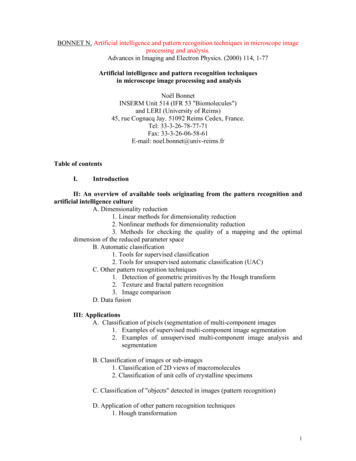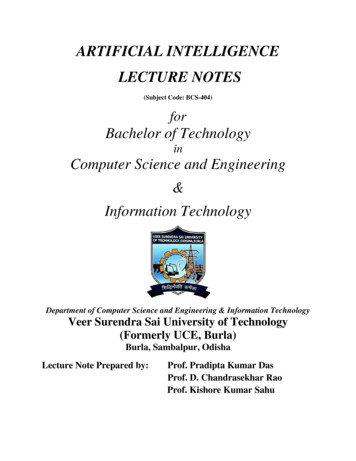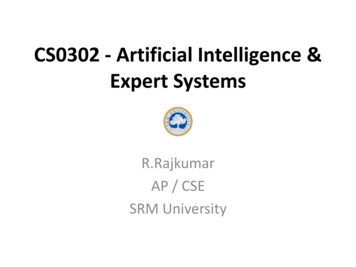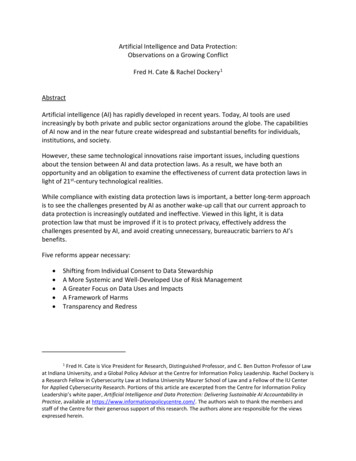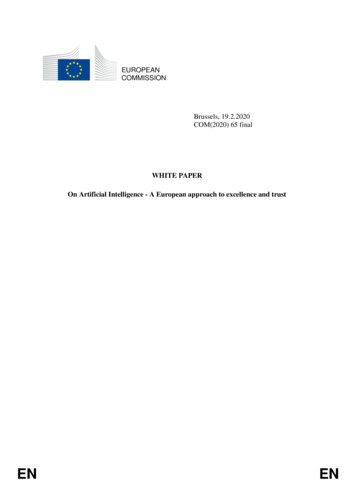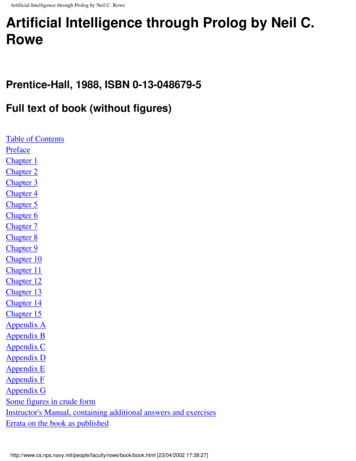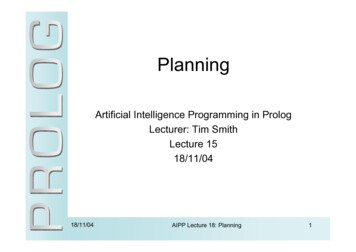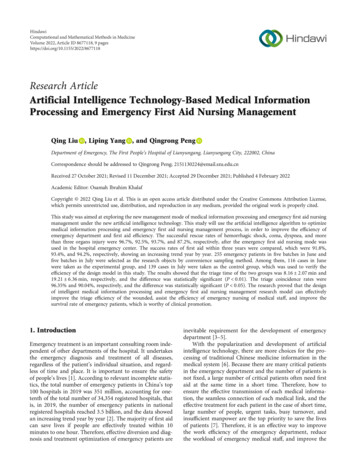
Transcription
HindawiComputational and Mathematical Methods in MedicineVolume 2022, Article ID 8677118, 9 pageshttps://doi.org/10.1155/2022/8677118Research ArticleArtificial Intelligence Technology-Based Medical InformationProcessing and Emergency First Aid Nursing ManagementQing Liu , Liping Yang , and Qingrong PengDepartment of Emergency, The First People’s Hospital of Lianyungang, Lianyungang City, 222002, ChinaCorrespondence should be addressed to Qingrong Peng; 2151130224@email.szu.edu.cnReceived 27 October 2021; Revised 11 December 2021; Accepted 29 December 2021; Published 4 February 2022Academic Editor: Osamah Ibrahim KhalafCopyright 2022 Qing Liu et al. This is an open access article distributed under the Creative Commons Attribution License,which permits unrestricted use, distribution, and reproduction in any medium, provided the original work is properly cited.This study was aimed at exploring the new management mode of medical information processing and emergency first aid nursingmanagement under the new artificial intelligence technology. This study will use the artificial intelligence algorithm to optimizemedical information processing and emergency first aid nursing management process, in order to improve the efficiency ofemergency department and first aid efficiency. The successful rescue rates of hemorrhagic shock, coma, dyspnea, and morethan three organs injury were 96.7%, 92.5%, 93.7%, and 87.2%, respectively, after the emergency first aid nursing mode wasused in the hospital emergency center. The success rates of first aid within three years were compared, which were 91.8%,93.4%, and 94.2%, respectively, showing an increasing trend year by year. 255 emergency patients in five batches in June andfive batches in July were selected as the research objects by convenience sampling method. Among them, 116 cases in Junewere taken as the experimental group, and 139 cases in July were taken as the control group, which was used to verify theefficiency of the design model in this study. The results showed that the triage time of the two groups was 8:16 2:07 min and19:21 6:36 min, respectively, and the difference was statistically significant (P 0:01). The triage coincidence rates were96.35% and 90.04%, respectively, and the difference was statistically significant (P 0:05). The research proved that the designof intelligent medical information processing and emergency first aid nursing management research model can effectivelyimprove the triage efficiency of the wounded, assist the efficiency of emergency nursing of medical staff, and improve thesurvival rate of emergency patients, which is worthy of clinical promotion.1. IntroductionEmergency treatment is an important consulting room independent of other departments of the hospital. It undertakesthe emergency diagnosis and treatment of all diseases,regardless of the patient’s individual situation, and regardless of time and place. It is important to ensure the safetyof people’s lives [1]. According to relevant incomplete statistics, the total number of emergency patients in China’s top100 hospitals in 2019 was 351 million, accounting for onetenth of the total number of 34,354 registered hospitals, thatis, in 2019, the number of emergency patients in nationalregistered hospitals reached 3.5 billion, and the data showedan increasing trend year by year [2]. The majority of first aidcan save lives if people are effectively treated within 10minutes to one hour. Therefore, effective diversion and diagnosis and treatment optimization of emergency patients areinevitable requirement for the development of emergencydepartment [3–5].With the popularization and development of artificialintelligence technology, there are more choices for the processing of traditional Chinese medicine information in themedical system [6]. Because there are many critical patientsin the emergency department and the number of patients isnot fixed, a large number of critical patients often need firstaid at the same time in a short time. Therefore, how toensure the effective transmission of each medical information, the seamless connection of each medical link, and theeffective treatment for each patient in the case of short time,large number of people, urgent tasks, busy turnover, andinsufficient manpower are the top priority to save the livesof patients [7]. Therefore, it is an effective way to improvethe work efficiency of the emergency department, reducethe workload of emergency medical staff, and improve the
2success rate of treatment of critically ill patients by integrated design of the whole emergency treatment, medicalinformation circulation, patient diversion, and departmentturnover in advance and optimization by using artificialintelligence [8–10].In emergency first aid nursing management process, itwill be divided into many links and each link is closelylinked [11]. First, from the 120 ambulances, preliminary firstaid including hemostasis, cardiopulmonary resuscitation,and bone reduction will be carried out for patients. At thesame time, the clinical signs and disease conditions ofpatients will also be preliminarily diagnosed through theon-board medical system. After the ambulance is escortedto the hospital, rapid clinical diagnosis and triage will be carried out, and the patients are divided and classified by triage,so that patients can get corresponding professional medicalrescue. At the end of first aid, it is necessary to refer patientswho are in need, and some patients need hospitalizationnursing. At this time, the first aid medical information needsto be transferred in multiple departments [12–15]. Completeemergency first aid nursing management needs to cover theabove aspects, complete medical information processing,and emergency first aid nursing management through medical staff, which not only provides a lot of meaningless repetitive work but also is difficult to avoid mistakes [16, 17].Therefore, this study will use the Internet, 4G communication, local area network, and other information technologies to build a set of medical information processingand emergency first aid nursing management system basedon artificial intelligence, and it was successfully applied toclinical emergency activities. The system realizes the information sharing between hospital emergency and medicalstaff in other departments, optimizes the transmissionchannel of medical information, and can play a scientificand effective shunt for patients, shorten the first aid timeof individual patients, and effectively improve the successrate of patient treatment. The process system is mainlydivided into two parts, which are applied to the optimization of the overall emergency first aid nursing management process and the medical information processingmodule based on artificial intelligence technology.In summary, this study selects the emergency data inhospital within one year based on artificial intelligence medical information processing and emergency first aid nursingmanagement system constructed in this study and randomlyselects 10 batches of emergency patients admitted in thesecond year as the research object to study the reception efficiency of routine emergency process and emergency processconstructed in this study.2. Materials and Methods2.1. Research Objects. In this study, 321 patients who werecritically ill admitted to the hospital within one year wereselected as the research subjects, including 83 cases of trafficaccident injury. 125 cases were admitted because of suddenheart disease, stroke, shock, and other sudden diseases. 59patients were admitted because of fighting, falling injury,and accidents. 17 cases were hospitalized because of foodComputational and Mathematical Methods in Medicinepoisoning and misuse of toxic substances. The remaininginconvenience classification or too low number of patientswas 37 cases. There were 196 males and 125 females. Theywere 5-78 years old with an average age of 35:5 12:6 yearsold. According to the general emergency classification, 42cases were grade I, 84 cases were grade II, 113 cases weregrade III, and 82 cases were grade IV [18].10 batches of 255 emergency patients admitted due totraffic accidents were selected by convenience samplingmethod in all patients in the second year. Among them,116 patients in five batches in June were selected as theexperimental group, including 83 males and 33 females, agedfrom 16 to 69 years with an average age of 24:7 16:1 years.The maximum number of hospitalized patients in a singlebatch was 18, and the minimum number of hospitalizedpatients in a single batch was 2. In addition, 139 patientsin five batches in July were selected as the control group,including 88 males and 51 females, aged from 16 to 71 yearsold, with an average age of 25:2 18:4 years old. The maximum number of hospitalized patients in a single batch was24, and the minimum number of hospitalized patients in asingle batch was 2. This study had been approved by ethicscommittee of hospital, and patients’ families had beeninformed of this study and signed informed consents.There was no significant difference in the general clinicaldata between the two groups (P 0:05), and the specificresults are shown in Figure 1. Inclusion criteria include (1)age 16 years old and (2) emergency patients caused by traffic accidents and accidents. Exclusion criteria include (1)emergency patients without trauma and (2) no other majorfatal complications occurred.2.2. Emergency First Aid Nursing Management SystemProcess. The emergency first aid nursing management system process is shown in Figure 2.In view of the emergency first aid nursing managementand the construction of hospital information system, theemergency rescue process is roughly divided into three parts.The first part is “120 pre-hospital emergency.” By using 4Gcommunication technology and even the latest 5G communication technology, the “120” emergency vehicle is connected with the internal and external network servers. Themonitoring instruments in the vehicle are wirelessly communicated with high-speed data, so that the informationsuch as vehicle condition, vehicle GPS, vehicle rescue monitoring video, patient signs data, patient ECG, and patientoxygen saturation are related to the emergency commandcenter and emergency database. The relevant informationdata are transmitted in real time, which is convenient forinformation sharing and data archiving. The emergencymanagement is moved forward to prepare for hospital emergency first aid nursing management. The second part is theemergency first aid nursing management in hospital. Theworkstations of department directors, doctors, and nursesin the hospital are associated with the triage workstation inthe emergency department to facilitate hospital consultation.The third part is the management of hospital data. By transferring prehospital transmission information data and hospital emergency medical information to the hospital
Computational and Mathematical Methods in Medicine3120100Number806040200ManWomanAge 69Age 60Observation groupControl group(a)7060Number50403020100Single mostSingle lestLevel ILevel IILevel IIILevel IVObservation groupControl group(b)Figure 1: Comparison of individual clinical data of patients. Note: (a) The results of gender and age comparison between the two groups. (b)The comparison results of admission and emergency grading between the two groups.intranet and carrying out classified management, it is convenient for future use at any time.2.3. Emergency Department Workstation System. As the forefront of emergency first aid work, an emergency workstationdirectly determines the efficiency of emergency first aid workand the effective rate of first aid, which is extremely important for the entire emergency department. By combiningthe rapid development of artificial intelligence technologywith emergency diagnosis and treatment, a medical information processing system with emergency characteristics isconstructed to greatly improve the efficiency of emergencyfirst aid. In this study, based on the neural network algorithm, semantic network, natural language processing(NLP) algorithm, and the national diagnosis and treatmentguidelines and related literature as data resources, it buildsa set of medical information processing system based onontology semantic medical knowledge base and AI reasoning engine as the core [19–22]. The system will follow thenational clinical diagnosis and treatment norms, throughbig data to simulate the emergency first aid nursing manage-ment of clinicians, compare the input patient informationwith the database information, and provide all patients withauxiliary management including inquiry (for consciouspatients), examination, diagnosis, and treatment. Accordingto the characteristics of the emergency department, a supporting triage and preexamination system is also provided.Through database comparison and national clinical diagnosis and treatment norms, the emergency order of patients isarranged according to the critical grade of emergency nursing, and the patients with acute and critical diseases aregiven priority to as much as possible. The specific processis shown in Figure 3.With the above management system, patients will be distinguished by identification wristbands. Three-color wristbands will be used for management according to patients’disease conditions. As shown in Figure 3, red, yellow, andgreen wristbands will be used. Red represents grade I andII patients, respectively, endangered patients and criticallyill patients. Yellow is grade III, representing emergencypatients. Green is a class IV patient, a nonemergency patient.Among them, red patients as key patients will have the
4Computational and Mathematical Methods in MedicineDoctors and nursesmobile workstations120 Servicescheduling centerDirector, doctor,nurse workstation2UTriage tablePre-hospital emergencyworkstationSwitches4G/5GPre-hospital doctor’sworkstationPrehospitalserverApplication DataserverserverInformation integrationservestationOutside thehospital networkThe region agentThe hospital InternetstationFigure 2: General process of emergency first aid nursing management system.Class I: Endangered patientsClass II: Critical patients120 Emergency vehiclemonitoring systemClass III: EmergencypatientsClass IV: Transmission ofphysical sign dataConsultation andpre-examinationGrading and diagnosisTriage and registrationEmergency patientsFigure 3: Intelligent emergency triage management system.
Computational and Mathematical Methods in Medicine5Pre-hospitalemergency rkstation(c)After receiving the information, theterminal in the hospital willautomatically prompt the alarm andinform the emergency medical staffto prepare for the batch diagnosis ofinjuries. The staff of the commandcenter and emergency departmentcan guide the on-site rescue, so thatthe emergency department canadvance the rescue, realizeinformation sharing and make fullpreparations for the next treatment.120 Pre-hospitalemergencymanagement systemAmbulanceThrough Internet services such aspositioning, video acquisitiontechnology, 4G, 5G or opticalfiber, and digital subscriber line,the front end of the hospital cantrack the live pre-hospitaltransport of patients in real time,and upload information such asinjury data and vital signs on thefirst aid scene and ambulance.(a)When it is connected to theintelligent system ofemergency vehicle, medicalstaff can make preparations inadvance according to thepatient treatment informationtransmitted by high-speeddata and video. After thepatients arrived at the rescuearea of the emergencydepartment, the medical staffand the first aid personnelhanded over the rescuesituation, and completed thebasic information of thepatients and related statusassessment.(b)Hospitaldata serverFor thunder medicalinformation data, all need to bestored independently in thehospital, convenient to keep filesand timely read.(e)Emergency stageI-III patientsThe application of the intensive careinformation workstation realizes theguidance of the monitoring data ofpatient bedside monitoring equipment,ventilator and other instruments orworking data to the nursing electronicmedical record. According to thechanges of medical orders, the systemcan collect the information of patients'vital signs and instrument parameters inreal time, realizing the high degree ofinformation sharing.(d)Figure 4: Detailed process of emergency first aid nursing management ((a) the prehospital emergency part, (b) the emergency departmentworkstation, (c) the command center, (d) the rescue area, and (e) the database).highest priority for rescue, yellow patients as emergencypatients will be treated as severe emergency, and greenpatients are ranked as the lowest priority in emergency firstaid nursing management. The wristband will not only serveas the identification of triage sorting but also carry patientinformation and two-dimensional code, which will be usedas the patient’s personal information code for referral, registration, recharge and payment, printing laboratory sheet, feeinquiry, and other purposes.The system will be connected to the “120” emergencyvehicle intelligent system, the emergency department medi-cal staff will receive the patient’s medical informationaccording to 4G or 5G communication technology, as earlyas possible to prepare for emergency. The patient’s generalpersonal information and specific medical information arecompared and summarized when the patient reaches theemergency department, and the patient’s information is professionally evaluated by the intelligent emergency workstation to assist the medical staff. For patients with highscores, the system will remind medical staff to be ready tocontact specialists and be ready for referral as soon as possible. For emergency patients, the system will be connected
6Computational and Mathematical Methods in Medicinewith each bed monitor, ventilator, and other instruments,real-time collection of patients’ medical information and filecollection, and the patient’s every link of information areconcentrated in electronic files, in order to be convenientaccess at any time.2.4. Effect Verification of Artificial Intelligence EmergencyFirst Aid System. In order to verify the practical effectivenessof the artificial intelligence-based integrated medical information processing and emergency first aid nursing management system designed in this study, the experiment isdivided into two parts. The first part is the verification ofthe intelligent emergency triage management system. Thisexperiment uses the system in the emergency departmentfor one year to collect the emergency response efficiency ofvarious types of common emergency symptoms in this year,so as to observe the macroresponse efficiency of the emergency response nursing management system based on artificial intelligence. In the second part, a convenience samplingmethod will be used to select 10 batches of emergencypatients treated as research objects; they are randomlydivided into the experimental group and control group.The experimental group will use the artificial intelligencebased emergency first aid nursing management systemdesigned in this study for first aid activities, while the controlgroup will use the traditional manual receiving and triagemethod for first aid, so as to observe the triage time and triage coincidence rate of the system.2.5. Evaluation Indicators. In this study, the average triagetime, the coincidence rate of triage results, and the triagetime of critically ill patients were compared between thetwo groups, which were used as the evaluation standard forthe effective management of emergency care.The average triage time refers to the time taken bypatients from the triage station to the triage station. The triage time of critically ill patients refers to the definition ofcritically ill patients with CRAMS (Circulation, Respiration,Abdomen, Motor, Speech) trauma score 6 and modifiedearly warning score ðMEWSÞ 5. The coincidence rate oftriage: in the two groups of patients, the random numbertable method was used to randomly extract the preexamination triage information of patients, and the triage level washidden. Experts were invited to retrospectively triage, andthe differences between the two triage levels were compared.The specific calculation formula is as follows.T A 100%,Bð1Þwhere T is the coincidence rate of triage, A is the numberof cases in which the retrospective triage results of expertsare consistent with the original triage results, and B is thetotal number of patients extracted.2.6. Statistical Method. The data in this study were analyzedby SPSS19.0 statistical software. The measurement data wereexpressed as mean standard deviation ( x s), and thecount data were expressed as percentage (%). One-way analysis of variance was used for pairwise comparison. P 0:05831827154Hemorrhagic shockComaDyspneaVisceral injuryFigure 5: Types of severe trauma complications.or P 0:01 indicated that the difference was statisticallysignificant.3. Results3.1. Integrated Medical Information Processing andEmergency First Aid Nursing Management Process Based onArtificial Intelligence. The following chart is the constructionprocess of the integrated medical information processingand emergency first aid nursing management system basedon artificial intelligence (Figure 4).3.2. Rescue Results of Patients with Different Degrees ofIllness. The types of diseases and the rescue success rate ofsevere traumatic complications in the emergency department within one year were summarized (Figures 5 and 6),and the first aid results within three years were compared(Figure 7).Figure 5 is the type and proportion of common complications in emergency trauma patients within one year.According to Figures 6 and 7 data, it can be clearly reflectedin the use of artificial intelligence-based integrated medicalinformation processing and emergency first aid nursingmanagement, the overall emergency first aid efficiency hasgradually improved, and there is an obvious upward trendin three years.3.3. Comparison of Emergency Effective Rate of SelectedPatients. Figure 8 is the comparison of emergency triagetime and emergency triage coincidence rate between thetwo groups. Triage time of the experimental group and thecontrol group were 8:16 2:07 min and 19:21 6:36 min,respectively, and the difference was statistically significant(P 0:01). The triage coincidence rates were 96.35% and90.04%, respectively, and the difference was statistically significant (P 0:05).4. DiscussionAt present, in the general emergency room triage, nursesperform emergency grade assessment according to the physician on the patient’s self-report, clinical signs, disease performance, test data, and various scales of, and then, patients
Computational and Mathematical Methods in Medicine7989694Rate (%)929088868482HemorrhagicshockComaDyspneaVisceral injuryFigure 6: Emergency effective rate of different complications.94.594First aid success rate (%)93.59392.59291.59190.52018 year2019 year2020 yearFigure 7: Comparison of effective rate of emergency care in three years.are divided into different grades. All medical accidents inShanghai, China from 1990 to 2015 were statistically studiedby Gao et al. [23]. The study found that the difference indiagnosis was the main error type in all medical accidents,and it mainly occurred in men, in the age group under 10and 50-70 years old. Patients carrying respiratory diseases,tumors, and hypertension were independent predictors oferror diagnosis. The conclusion showed clinical decisionmaking system can effectively improve the accuracy of clinical diagnosis in 68% of the experiments. Through researchat home and abroad, the use of artificial intelligence technology to assist the medical room effectively reduces the effective means of medical accidents. The emergencydepartment often appears a large number of critically illpatients need to be diagnosed at the same time, which causesgreat pressure on the medical staff of the emergency department, and often inevitably leads to misdiagnosis and misseddiagnosis, resulting in aggravation, delay, and even death ofcritically ill patients. Therefore, it is an inevitable trend tointroduce artificial intelligence technology into the emergency department.This study is also based on the above reasons, throughartificial intelligence technology for emergency medicalinformation unified processing, and emergency first aidnursing management process optimization, in order toimprove the efficiency of emergency first aid. This studyinnovatively introduces artificial intelligence, has a certainplanning for the overall emergency first aid process, makinghardware and software match each other, and has more efficient improvement efficiency. Through many years of clinical practice and extraction control experiment in thehospital, this study studies in detail the design of integratedmedical information processing and emergency first aidnursing management system based on artificial intelligence
8Computational and Mathematical Methods in Medicine30⁎25Time (min)20151050Experimental groupControl group(a)97969594Rate (%)939291 9089888786Experimental groupControl group(b)Figure 8: Comparison of triage time and coincidence rate between the two groups ((a) the proportion of emergency triage time in the twogroups and (b) comparison of triage coincidence rate two groups; in (a), compared with the experimental group, P 0.01; in (b), comparedwith the experimental group, P 0:05).in emergency first aid effectiveness and the speed and accuracy of triage. In the hospital emergency common complications, the rescue success rate of hemorrhagic shock was96.7%, the rescue success rate of coma was 92.5%, the rescuesuccess rate of dyspnea was 93.7%, and the rescue successrate of organ injury combined with more than three was87.2%. The success rates of first aid in three years were compared, which were 91.8%, 93.4%, and 94.2%, respectively,showing an increasing trend year by year. The triage timeof emergency patients with the system designed in this studywas 8:16 2:07 min, and the triage time of emergencypatients with traditional emergency rescue process was19:21 6:36 min; the difference was statistically significant(P 0:01). The triage coincidence rate of emergency patientsusing the system designed in this study was 96.35%, whilethat of emergency patients using the traditional emergencyrescue process was 90.04%, and the difference was statistically significant (P 0:05). As for Kawamoto et al. [24],through the application of clinical decision-making systemin clinical practice, more than 70 related experimentalreports were studied in multiple control test retrieval librar-ies. It is consistent with the results of this study. In summary,under the new management mode of medical informationprocessing and emergency first aid nursing managementunder the new artificial intelligence technology, the triageefficiency of the wounded has been improved, the emergencynursing efficiency of auxiliary medical staff, and the survivalrate of emergency patients have been improved.5. ConclusionIn this study, the clinical data of three years of emergencytreatment in the hospital were selected, and 10 batches ofemergency patients were selected for emergency triage timeand triage accuracy to study the integrated medical information processing and emergency first aid nursing management system based on artificial intelligence designed in thisstudy. The results proved that the system can effectivelyimprove the efficiency and accuracy of emergency first aid.There is the room for improvement in the construction ofthe system in this experiment. Especially, artificial intelligence should be more applied. It is expected that more
Computational and Mathematical Methods in Medicinedomestic and foreign research can improve the research ofartificial intelligence in the treatment and diagnosis. Thisstudy can play a guiding role in the improvement and construction of hospital emergency department and providesome experimental data.Data AvailabilityThe data used to support the findings of this study are available from the corresponding author upon request.Conflicts of InterestThe authors declare no conflicts of interest.References[1] M. Dorsett, R. J. Cooper, B. R. Taira, E. Wilkes, and J. R. Hoffman, “Bringing value, balance and humanity to the emergencydepartment: the right care top 10 for emergency medicine,”Emergency Medicine Journal, vol. 37, no. 4, pp. 240–245, 2020.[2] L. Peng and K. Hammad, “Current status of emergencydepartment triage in mainland China: a narrative review ofthe literature,” Nursing & Health Sciences, vol. 17, no. 2,pp. 148–158, 2015.[3] A. Kumar, D. Lakshminarayanan, N. Joshi, S. Vaid, S. Bhoi,and A. Deorari, “Triaging the triage: reducing waiting timeto triage in the emergency department at a tertiary care hospital in New Delhi, India,” Emergency Medicine Journal, vol. 36,no. 9, pp. 558–563, 2019.[4] S. Yuzeng and L. L. Hui, “Improving the wait time to triage atthe emergency department,” BMJ Open Quality, vol. 9, no. 1,article e000708, 2020.[5] E. S. Henry, S. Robertshaw, and J. Stephenson, “Improvingaccessibility to outpatient clinics for adults with suspected seizures from the emergency department: a quality improvementproject,” Seizure, vol. 93, pp. 160–168, 2021.[6] S. Jalal, W. Parker, D. Ferguson, and S. Nicolaou, “Exploringthe role of artificial intelligence in an emergency and traumaradiology department,” Canadian Association of RadiologistsJournal, vol. 72, no. 1, pp. 167–174, 2021.[7] W. Zhang, M. Fang, D. Dong et al., “Development and validation of a CT-based radiomic nomogram for preoperative prediction of early recurrence in advanced gastric cancer,”Radiotherapy and Oncology, vol. 145, no. 4, pp. 13–20, 2020.[8] B. Schouten, B. E. Driesen, H. Merten et al., “Experiences andperspectives of older patients with a return visit to the emergency department within 30 days: patient journe
2.2. Emergency First Aid Nursing Management System Process. The emergency first aid nursing management sys-tem process is shown in Figure 2. In view of the emergency first aid nursing management and the construction of hospital information system, the emergency
